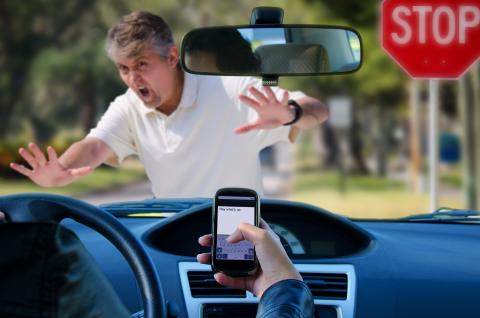Cellphones, Distracted Driving, and Unintended Consequences

Patricio V Marquez
January 27, 2025
“It only takes a second, but it can have life-long repercussions. Texting and driving may seem innocent enough (and it's certainly tempting to do), but every year thousands of faultless drivers and passengers are killed due to the negligence of other drivers.”
--The Zebra, an independent insurance advisor and quote comparison site with headquarters in Austin, Texas
“Sending or reading a text takes your eyes off the road for 5 seconds. At 55 mph, that's like driving the length of an entire football field with your eyes closed.”
--National Highway Traffic Safety Administration, part of the U.S. Department of Transportation
Nowadays, it is a common sight on city streets and highways in countries across the world to observe the drivers of motor vehicles using their mobile devices, mainly smartphones, and in particular texting applications, while operating the vehicles.
I must admit that on occasions I have been guilty of this behavior—whether to take or make a call, quickly check emails, search for directions using Google Maps, or simply to connect to Spotify looking for an old song.
While a mea culpa is often the first step in addressing a problem, it is important to recognize—without moralizing—that this behavior can have deadly consequences.
Here, I explore some aspects of this issue in more detail.
What is Distracted Driving?
Distracted driving involves engaging in any activity that takes the driver's attention away from operating a vehicle. This behavior significantly increases the risk of motor vehicle crashes, endangering not only the driver but also passengers in the vehicle and unsuspecting vulnerable road users, such as pedestrians, cyclists, and Innocent bystanders waiting at the bus stop.
There are three primary types of distractions:
• Visual: Taking your eyes off the road.
• Manual: Taking your hands off the wheel.
• Cognitive: Taking your mind off driving.
Some common signs of distracted driving include:
- Driving too fast or too slowly
- Failing to use turn signals
- Running red lights
- Swerving in and out of lanes
Each of these distractions can pose a serious threat to road safety. As suggested by the results of a 2019 analysis by Dingus et al., performing visual-manual tasks—such as hand-held texting, browsing, or dialing—can increase crash risk by approximately 2.5 times. Previously, in a 2016 analysis, Dingus et al. reported a 12-fold increase in crash risk for dialing and a 6-fold increase for texting. Likewise, when preoccupied with work-related stress, personal problems, or upcoming plans, we may accidentally miss important visual signs such as traffic lights, road signs, or the actions of other drivers, increasing the risk of road crashes.
The results of in-depth analyses of driver inattention using the driving data collected in the 100-Car Naturalistic Driving Study suggest that a critical contributing factor to this heightened risk is the increased time drivers spend looking away from the road.
Prevalence and Impact of Distracted Driving
The findings from the 2024 ESRA (E-Survey of Road users’ Attitudes), a joint initiative of road safety institutes, research centers, public services, and private sponsors from across the world, show that talking on a hands-free mobile phone while driving a car was the most prevalent self-declared behavior in the three studied regions: 51.0 percent in Europe, 47.6 percent in America, and 44.3 percent in Asia and Oceania. A lower percentage of car drivers reported talking on a hand-held mobile phone and reading a message or checking social media/news, however, the prevalence of these behaviors was similar within each region: 22.2 percent and 23.2 percent in Europe; 30.5 percent and 31.5 percent in America; 27.6 percent and 24.5 percent in Asia and Oceania. Overall, the use of a mobile phone while driving a car was found to be more prevalent among men than women, and in younger car drivers than in the older ones.
Distracted driving has severe consequences, impacting thousands of individuals every year. The World Health Organization (WHO) reports that approximately 1.19 million people die annually due to road traffic crashes, making them a leading cause of death worldwide. A substantial portion of these events is attributed to driver distractions, including mobile phone use.
A recent systematic review synthesizing evidence on the proportion of drivers injured or killed in motor vehicle collisions due to mobile device distraction reveals significant global variation. The proportion of road traffic injuries and fatalities attributed to this distraction ranges from 0.04 percent to 44.7 percent, with a median of 3.4 percent. This wide variation highlights the challenges associated with data collection and reporting across different countries.
The evidence from developed countries like the United States, with robust statistical systems, illustrate the deadly toll of distracted driving. In 2022, more than 3,300 people were killed and an estimated 290,000 people were injured in crashes involving distracted drivers, according to the latest data from the National Highway Traffic Safety Administration (NHTSA). Notably, about 1 in 5 of those who lost their lives in such crashes were not in vehicles--they were pedestrians, cyclists, or otherwise outside a vehicle. Even more concerning from a human capital development perspective of a country, young adult and teen drivers are at a higher risk of distracted driving compared to other age groups, and in fatal crashes involving distracted drivers, a higher percentage of drivers aged 15–20 were distracted compared to those aged 21 and older.
Distracted driving is a growing problem and one of the most dangerous behaviors in Europe as well. According to the European Commission (2022) Road safety thematic report, distraction plays a role in 5 - 25 percent of crashes in Europe. In 2019, distracted driving was responsible for over 3,000 fatalities and 120,000 injuries on European roads.
However, results of naturalistic driving studies, which aim to observe drivers' behavior in their natural driving condition, i.e., in an unobtrusive driving environment, without any experimental control influencing driver's behavior, suggest that the percentage of crashes related to distraction is likely higher than reported. Typically, in these types of studies, vehicles are equipped with several small cameras and sensors, which continuously and inconspicuously register vehicle maneuvers, driver behavior, and external conditions. A 2016 study by Dingus et al., for example, found that 68.3 percent of 905 crashes—both injurious and property damage incidents—involved some form of observable distraction, with many secondary tasks, particularly those involving handheld electronic devices, posing significant risks to driver safety.
It is important to note that available figures on the impact of distracted driving may be underreported due to challenges in accurately identifying distraction as a contributing factor in crashes. Nevertheless, the existing data underscores the urgent need for increased awareness and preventive measures to address distracted driving on a global scale.
How to Prevent Distracted Driving?
Preventing distracted driving requires a multifaceted approach that combines governmental action, technological advancements, and individual responsibility. By addressing the issue from multiple angles, we can create a safer driving environment and significantly reduce the risks associated with driver distraction.
As highlighted in the 2024 European Road Safety Observatory Distraction report, there are effective measures against distracted driving, which include: strict enforcement of bans on the use of handheld devices, including through the use of smart cameras: building rumble strips into road infrastructure; awareness campaigns; driver education through licensing; and in-vehicle technology that warns or intervenes when departing from a lane or approaching too close to a vehicle in front.
Influencing Behavioral Change
Governments at various levels, whether central or local, have the power to actively combat distracted driving through a combination of legislation, enforcement, and awareness campaigns. They have the mandate within their jurisdictions to enact laws prohibiting texting or using handheld devices while driving. Such laws and regulations provide the judicial backing needed to implement enforcement campaigns, including those specifically targeting cell phone use to reduce distracted driving behaviors.
Raising awareness of the risks of distraction through public campaigns and driver education during the licensing process are also critical tools to highlight the dangers of distracted driving and reduce its social acceptability. For example, the "Put the Phone Away or Pay" campaign launched in 2024 by the US NHTSA, aims to remind drivers of the deadly dangers of distracted driving and the potential legal consequences they could face.
Infrastructure and Technology Countermeasures
As suggested by a 2023 European Commission report, road infrastructure and new vehicle technologies measures can be effective for mitigating the consequences of distracted driving.
To prevent running off the road due to distraction, longitudinal rumble strips can be implemented to warn drivers with sound and vibration. Rumble strips are considered a cost-effective countermeasure, with an estimated reduction of single-vehicle crashes by 25 percent, and a 95 percent probability that the actual reduction is between 5 percent and 41 percent. Additionally, the placement of potentially distracting advertising panels along roadsides needs to be carefully regulated to minimize driver distraction.
New vehicle technologies designed to combat distracted driving are promising, though their overall effects are still being evaluated. Advanced Driver Assistance Systems (ADAS), such as forward collision warnings and lane departure warnings, aim to mitigate the consequences of distracted driving. For example, since mid-2024, a new EU regulation mandates the inclusion of an advanced driver distraction warning system in all new vehicles.
Personal Responsibility in Preventing Distracted Driving
Individual actions can also play a significant role in reducing distracted driving. As drivers, we can use settings that silence our phones or block notifications while driving. Passengers can help by calling attention to distractions and offering assistance with tasks such as navigation. Parents can establish clear rules regarding distracted driving for young drivers. More importantly, all of us can serve as role models by keeping our focus on the road and encouraging others to do the same.
Takeways
We need to be clear and remember that distracted driving is a global public health concern that is largely preventable. By combining legislative measures, infrastructure improvements, technological advancements, and individual actions, societies can prevent distracted driving and ensure safer roads for everyone.
Source of Images:
Image 1. Shutterstock 322470743 "An irresponsible texting driver is about to run over a pedestrian at an intersection which shows how dangerous texting and driving is".
Image 2. Shutterstock 84661507 "Put Your Phone Down Green Road Sign".

